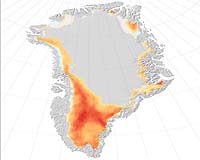| . |  |
. |
Paris (AFP) May 23, 2010 The rapid decline of mammoths and other megafauna after humans spread across the New World may explain a bone-chilling plunge in global temperatures some 12,800 years ago, researchers reported Sunday. The 100-odd species of grass-eating giants that once crowded the North American landscape released huge quantities of methane -- from both ends of their digestive tracks. As a heat-trapping greenhouse gas, methane is 30 times more potent than carbon dioxide (CO2). It was not enough to trigger runaway global warming. But when all that gaseous output suddenly tapered off, it caused or at least contributed to a prolonged freeze known as the Younger Dryas cold event, they argue. If so, the "Anthropocene epoch" -- the era of major human impacts on Earth's climate system -- began not with the industrial revolution in the 1800s, but the large-scale influx of two-legged predators to the Americas more than 13,000 years earlier. Calculations by a trio of researchers led by Felisa Smith of the University of New Mexico, published in Nature, show how all the pieces of this previously unsolved puzzle might fit together. Extrapolating from data on cows and other modern-day ruminants, the scientists estimated the total methane output of pre-historic megafauna at nearly 10 trillion grams per year. At the same time, ice-core samples reveal that an abrupt drop in atmospheric methane levels of 180 parts per billion by volume (ppbv) coincides with both the virtual extinction of these gas-gushing herbivores and the onset of the deep chill that followed. Greenland ice cores from other periods show that a reduction in methane levels of 20 ppbv corresponds to a reduction in temperature of roughly 1.0 degrees Celsius (1.8 degrees Fahrenheit). That would add up to a decrease of 9.0 to 12.0 C (16 to 22 F), a near-perfect match with the Younger Dryas cold snap. "We find that the loss of megafauna could explain 12.5 to 100 percent of the atmospheric decrease in methane observed," the researchers said. The theory is bolstered by the fact that the plunge in concentration was two-to-four times faster than the five other largest methane drops during the last 500,000 years, suggesting a unique confluence of factors. "The megafaunal extinction is the earliest catastrophic event attributed to human activity," the study concluded. "We thus propose that the onset of the 'Anthropocene' [epoch] should be recalibrated to 13,400 years before present, coincident with the first large-scale migrations of humans into the Americas."
Share This Article With Planet Earth
Related Links Climate Science News - Modeling, Mitigation Adaptation
 Greenland Rapidly Rising As Ice Melt Continues
Greenland Rapidly Rising As Ice Melt ContinuesVirginia Key FL (SPX) May 21, 2010 Greenland is situated in the Atlantic Ocean to the northeast of Canada. It has stunning fjords on its rocky coast formed by moving glaciers, and a dense icecap up to 2 km thick that covers much of the island--pressing down the land beneath and lowering its elevation. Now, scientists at the University of Miami say Greenland's ice is melting so quickly that the land underneath is rising at an acce ... read more |
|
| The content herein, unless otherwise known to be public domain, are Copyright 1995-2010 - SpaceDaily. AFP and UPI Wire Stories are copyright Agence France-Presse and United Press International. ESA Portal Reports are copyright European Space Agency. All NASA sourced material is public domain. Additional copyrights may apply in whole or part to other bona fide parties. Advertising does not imply endorsement,agreement or approval of any opinions, statements or information provided by SpaceDaily on any Web page published or hosted by SpaceDaily. Privacy Statement |